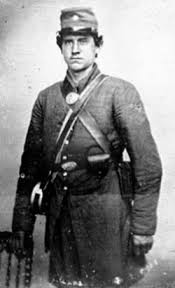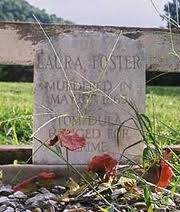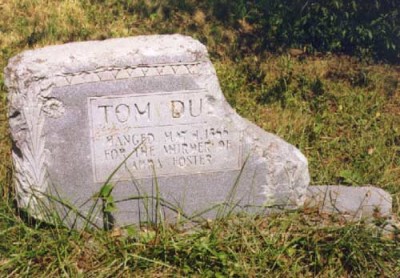In one of popular music’s most sublime ironies The Kingston Trio with their polished harmonies, conservative matching stage attire, and milquetoast clean-cut image turned a true 19th century story about lascivious promiscuity and murder into a chart-topping hit that briefly changed the economic trajectory of folk music.
The Kingston Trio (Dave Guard, Bob Shane, and Nick Reynolds – and later John Stewart) formed in 1957 in Palo Alto, California. The group recorded their first album in 1958 for Capital Records simply titled “The Kingston Trio.” It was to be the first of many best selling albums. Their success made folk music profitable for a while anyway and they served as inspiration for many musicians, most notably another hugely successful California band, the Beach Boys. But it was inarguably the Kingston Trio who single-handedly created the “college market” of record buying and who introduced the wider record buying public to traditional songs. They get a bad rap in folk circles for their commercial success and slick, well-rehearsed stage presence, but they loved and promoted traditional folk tunes and serious contemporary songwriters like Pete Seeger, Hoyt Axton, and Billy Ed Wheeler whose songs they recorded. When Guard left the band at the peak of their commercial success, it was to form the Whiskeyhill Singers, a band that would focus solely on traditional American music.
Just before the trio's first album was recorded they had heard the song “Tom Dooley” for the first time during an afternoon audition at the Purple Onion, a San Francisco folk club. They don’t remember who performed it but it was the version first published in Alan Lomax’s 1947 songbook “Folk Songs USA” that had been collected by musicologist Frank Warner who introduced it to the folk world at a concert in New York City in the 1940’s. Warner’s rendition was later adapted and arranged for publication by Charles & Ruth Seeger. The trio recorded this arrangement for their album.
Capital Records originally didn’t release any singles from the album and the song’s success was not the result of any kind of pre-planned commercial marketing strategy on the part of Capital Records. Rather it was word-of-mouth (ie. the folk process) that brought the song to a wider audience and commercial success. At their concert performances the trio would sell copies of the album. After a show at the ‘Hungry i’ in San Francisco a record store owner from Salt Lake City took a bunch of copies to sell in her family-owned record store. A Salt Lake City DJ purchased a copy and played “Tom Dooley” repeatedly on his show. He sent copies to DJ friends in Boston and Miami who also played the tune and soon enough other stations picked it up and as the album’s sales increased Capital Records eventually released that song as a single. It reached #1 on the charts just before Christmas and won a Grammy for “Best Country & Western Vocal Performance of 1958” much to the chagrin of real Country & Western performers. The album stayed on the charts for four years and even inspired a Hollywood movie, “The Legend of Tom Dooley” starring Michael Landon.
The folktale “Tom Dula” has a long history and is found in many forms throughout the south; in oral and written prose, poems, and in ballads. It can be entitled “Tom Dula” or “Tom Dooley” or “The Death of Laura Foster.” The story is simple: Tom murders his girlfriend Laura and runs away only to be caught by a sheriff named Grayson. He is convicted and is to be hanged. Most versions are told from the perspective of the murderer who admits his deed and laments his fate on the night before his execution. In some versions the murderer laments his fate while playing his banjo. In a few versions the murderer points to drink and women (of course!) as the source of his ruin.
The actual events surrounding Tom Dula and Laura Foster took place in 1866. They were recorded in the court records and by tabloid journalists who traveled all the way from cities in the north to cover the steamy and tragic story as it unfolded in the courtroom. Folklorist John Foster West used the court records, newspaper stories, historic documents (such as military records and county census information), oral histories, and the folklore record (songs, poems, and narratives) to separate out the facts from the fiction as best as he could. This is the story:
On Friday May 25, 1866 Laura Foster left her home in Caldwell County North Carolina on her father’s horse and was never seen alive again. A few weeks later a drunken Pauline Foster (probably no relation to Laura) told others that she and Tom Dula had killed Laura. As this revelation spread throughout the county Dula disappeared. He went to Johnson County, Tennessee using the name of Hall and got a job working briefly on Col. James Grayson’s farm. While he was gone the Caldwell County Sheriff began questioning Pauline who denied involvement but implicated Dula and Ann Foster Melton. A warrant was issued and the Sheriff sent two deputies on the trail of Dula. They eventually made contact with Col. Grayson who helped them overtake the fugitive. The deputies returned with him to the Wilkesboro Jail and in early September as Dula sat in jail, Laura’s body was found buried near his home. She had been stabbed. With Pauline as the State’s key witness Dula and Melton were indicted. Tom had two trials and was defended by Zebulon Vance the ex-Governor of North Carolina who provided his services pro bono, perhaps because Tom had been a Confederate soldier. He was convicted anyway and sentenced to hang. The night before his execution on May 1, 1868, he wrote out a confession that exonerated Ann Foster Melton. At her trial the following fall Ann was found innocent.
Tom had been a Confederate soldier since age 17. He was 22 years old in 1866 when he returned home to Reedy Branch in the hill country above the Yadkin River near the Blue Ridge Mountains of North Carolina. His family was not land-owning gentry of the fertile valley. They were hill people, the folks who worked the land owned by the gentry; “hillbillies” to outsiders. They were poor, unschooled, hardscrabble laborers, scratching a living from their homestead gardens or as tenant farmers, and from whatever work they could do for their well-off neighbors in the valley. When Tom returned home, he returned to all of this and to the loving embrace of Ann Foster Melton.
Ann and Tom had begun their affair when they were 14 or 15 years old. Ann was married at the time to James Melton, an older man, apparently a cobbler and a pretty handy worker who was relatively well off for a hill person. Ann was still married to James when Tom returned from war. They picked up where they left off romantically and James looked the other way…literally. Court testimony detailed how all three shared the same bedroom. And just as Ann’s long-term relationship with husband James didn’t keep her away from Tom, Dula’s long-term relationship with his lover Ann didn’t stop him from becoming involved with Ann’s cousin, Pauline Foster.
Pauline had moved to Reedy Branch in
1866 to work for James and Ann to earn money. She needed to pay for medicine to
treat her case of syphilis. She admitted on the witness stand that she had
sexual relations “on occasion” with Tom. On the witness stand Ann’s
brother also admitted to having sex with Pauline. Along with her promiscuity,
the court record also revealed her alcoholism. Meanwhile, the big city tabloids
were marveling at (and embellishing!) the depravity of these back wood’s
hillbillies. As one ‘journalist’ reported (without any real factual evidence):
““Pauline….is remarkable for nothing but debasement, and may be dismissed
with the statement that she has since married a white man and given birth to a
Negro child!”
So who was the murder victim Laura Foster? Possibly she’s related to Pauline and Ann in some way but the record isn’t clear on that. The court record and the tabloid coverage established that she lived 5 miles away in German’s Hill and was 22 years old. The folklore presents her as sweet, young, and virtuous, but the documentary evidence suggests that she was of “easy virtue.” On the witness stand Laura’s father Wilson Foster described how he had caught Tom and his daughter in bed “on one or two occasions.” Others also testified to having “intimate relations” with her. The local doctor testified that he treated Tom for syphilis and that Tom told him that he got it from Laura Foster.
Pauline and others testified that Tom
said that he was going to kill Laura because of the infection. Pauline also
testified that Ann Melton wanted to kill Laura, although it wasn’t clear
whether it was because of the venereal disease or out of jealousy. By the end
of the trial the evidence showed that all the individuals involved were
promiscuously involved and infected (at one point a witness blurts out “yes,
we all have the pox!”) but it was unclear about who infected who. In the
end Laura was murdered, perhaps a scapegoat, perhaps out of jealousy, either by
Tom Dula alone or with Ann Melton’s assistance. Laura is buried in German’s
Hill. Her gravestone is still there.
The evidence against Dula was purely circumstantial and hearsay. The prosecution’s key witness against him was Pauline; clearly alcoholic, possibly infected by Tom, and not very reliable or sympathetic. He was convicted anyway and was hanged in Statesville. He stood on a cart that was pulled out from under him, and died suspended from the makeshift cross beam placed between two uprights. His family claimed his body and took him to Elksville, North Carolina for burial. There’s a monument along the old Lenoir-Wilkesboro Road that supposedly marks his grave. It's been heavily vandalized and on it the date of his death is incorrect. But that’s all okay. His real and lasting monument is a song that made it to #1 on the Hit Parade.
Source: “The Ballad of Tom Dula” by John Foster West. Published by Parkway Publishers, Boone, North Carolina. 2002.
On American Pastimes: Versions by the Carolina Chocolate Drops, Frank Warner, Paul Clayton, the Kingston Trio, and Snakefarm.
















